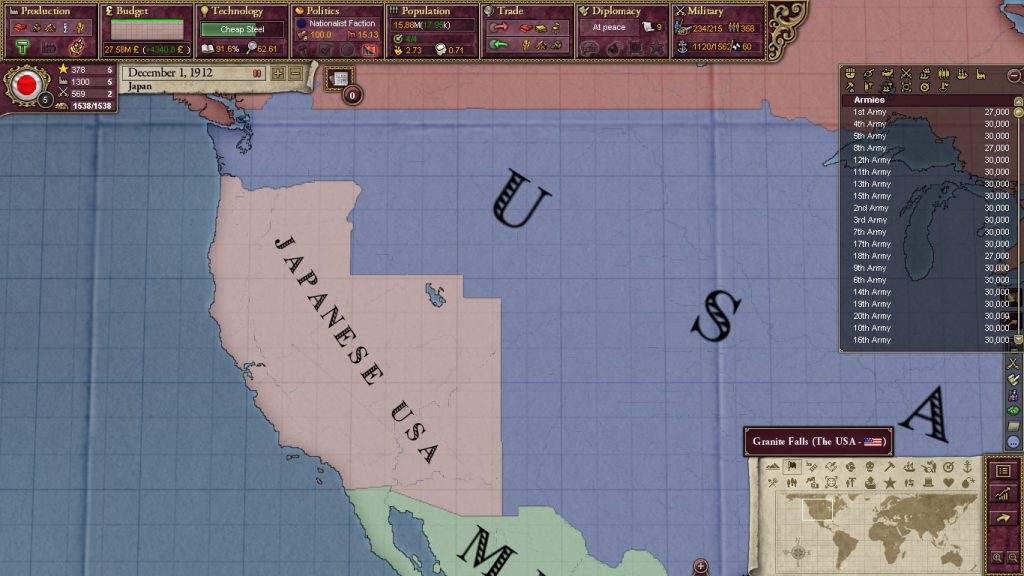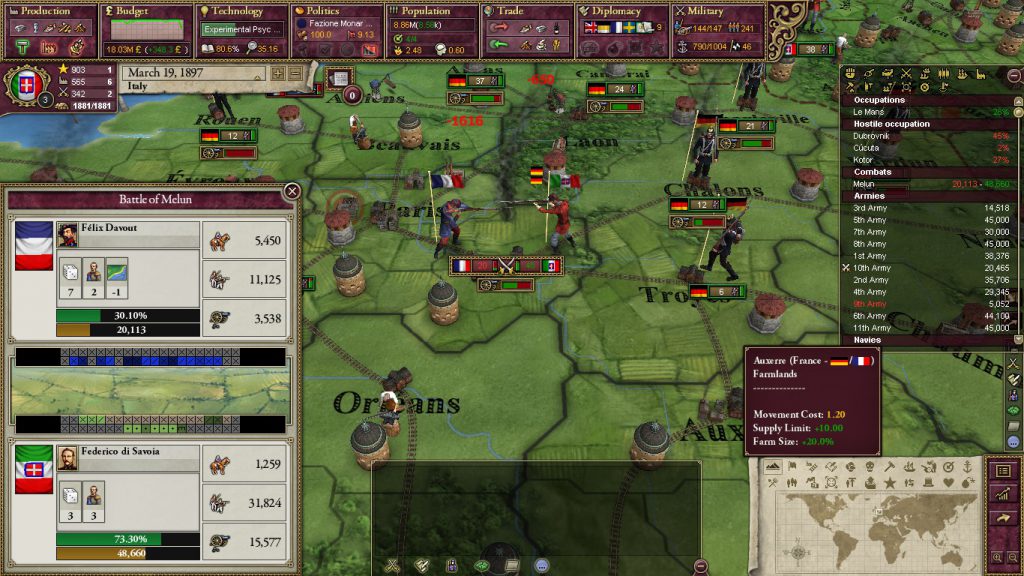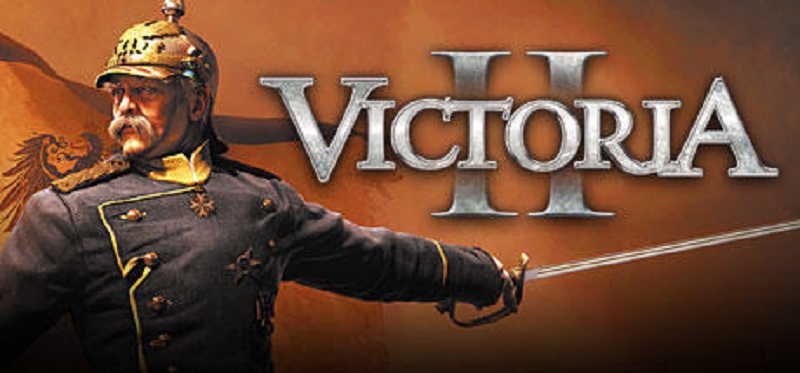The Victorian Era was a period of great advancement and upheaval in history. New technologies like the telephone and telegraph expedited communications, nations like Germany and Italy were united, and mankind continued to develop new and exciting ways to kill each other.
It was an epoch of international intrigue and internal turmoil, which, as it turns out, makes for a great recipe for a strategy title, and in 2010, Paradox Interactive wheeled out Victoria II, the sequel to 2003’s Victoria: An Empire Under the Sun. Would those seven years be enough time for Paradox to create the ultimate Victorian strategy experience?
(Author’s Note: I bought the bundled version of this game which included two expansion packs: A House Divided and Heart of Darkness. As such, this review describes concepts and features not found in the vanilla version.)
If not, it’s as close as anyone’s going to get. Victoria II allows you to rule literally any nation on earth from two different starting points, either the beginning of 1836 or the beginning of 1861, up until the year 1936. If you’ve been looking for a strategy game where you can take control of such nations as Liberia or Kokand, well, here you are. One thing you’ll notice about Victoria II is that, unlike other strategy games like Civilization or Rise of Nations, there aren’t any victory conditions, per se. There’s no way to “win” the game; you can’t take over the entire world, you won’t go to space, and you won’t be burying your opponents with your culture score.
While that might seem rather lame, it does make the whole experience a lot more open-ended; you decide what your goals are and how to go about achieving them. Do you unite Italy and fulfill the fascist desire for Mare Nostrum? Do you want to be the dominant colonizers of Africa? Do you take control of a nation like Dai Nam and attempt to maintain your independence from the European powers?
Perhaps the first thing you’ll notice when you actually fire the game up and get into playing is the sheer volume of variables you have control over with your nation. Here, you don’t just worry about having cities pump out troops or build structures, you’ll be concerned with things like your budget; you probably won’t have money to fund everything in your nation 100 percent, so you’ll have to make tough decisions about whether to spend on education or your military, for example. If your nation holds elections, you’ll have to take notice of what your voters care about and plan accordingly, because different parties in power can change what you can and can’t do; a liberal party in charge often means you won’t be able to build factories by yourself because they believe that power should be in the hands of investors and not the state. If you have factories, you might have to encourage people to train to work in factories instead of on farms, which not everyone will be on board with.

While it seems like a lot, it’s not as overwhelming as it sounds. Some things, like the Trade screen, will run itself; and most of the concepts, like encouraging your citizenry to do certain things or making political reforms can be done in a couple of clicks if you know where you’re looking. The Population screen, for example, can be a treasure trove of information about your workforce, allowing you to see exactly how many people you have doing what; and you can even break that information down further by literacy or ethnic groups. Now, that being said, I would definitely recommend taking a run through the tutorial before diving into a full game, but on the whole, running your empire is as streamlined as possible.
Almost as deep as the list of things you have control over is the list of things you have no influence over. Random events, both good and bad, crop up frequently, and can swing momentum hard one way or another. It’s a pretty rough kick in the jibblies when you’re trying to raise enough troops to form an army and suddenly, a cholera outbreak decimates your population. On the flip side of the coin, though, it’s a great feeling if a prospector finds gold in one of your colonies. The world here has a very active and fluid economy, so one day, you might be riding high on the hog with prosperous wineries and luxury furniture factories, only for the world to be plunged into war, sharply driving the demand for those products down and pushing your factories into insolvency. If you’re playing as an uncivilized nation, the first part of your game is going to be a slog, as you have to go through a process of Westernization before you can conduct regular research or ally yourself with civilized nations.
Your citizenry also has their own thoughts and opinions, expressed through the Militancy meter and the Consciousness meter. As militancy rises, rebel factions will develop in your nation, and if their demands aren’t met, they will launch uprisings to get what they want, and these are not always minor blips that your field armies can smash for light exercise; rebel movements can overthrow even long-standing governments, and over the course of a game, even major nations can be flipped by revolution. Even if they don’t take up arms against you, disgruntled people will also take the opportunity to emigrate en masse to more democratic nations in the Western Hemisphere.
Although you don’t have any set objectives, there are a couple of milestones along the way it would behoove you to reach. Every nation is ranked by a combination of Prestige, which is raised by researching certain technologies, being on the winning sides of wars, and generally running your country smoothly; Industrial Power, how many factories you have and how much they’re pumping out; and Military Power, which is pretty self-explanatory.
The top 8 nations are considered Great Powers, and have boosts to technology research rates, can take sides in a Crisis (which break out occasionally, usually caused by smaller nations looking to reclaim their ancestral lands from larger neighbors and is a good way for minor countries to achieve growth without attempting suicidal wars), and most importantly, Great Powers can create a Sphere of Influence. Nations in a Sphere of Influence are effectively obligated to join wars on the side of the Sphere’s leader, and they are forced to buy goods from and sell goods to the Sphere leader first. So if your country needs, say, iron for your factories, but you have very little in your country, you can attempt to sphere an iron-rich neighbor and obtain the resources you need without firing a shot.

Speaking of firing shots, yes, war is a substantial part of the package here, although in a much more subdued way than in other strategy games. Here, you can’t just decide on a whim to invade your neighbors. Before you can declare war, you have to obtain a casus belli, a reason to throw down. Sometimes, a country starts with a casus belli for historical reasons. For instance, Prussia starts with a casus belli on France to seize Alsace-Lorraine, because Prussia has to control that territory to formally unite Germany. If you don’t have a war justification, you have to manufacture one. You can create a war justification for a number of reasons: direct conquest of a small country, acquiring a state from a larger one, cutting a nation down to size (which forces them to disband most of their military and pay a substantial chunk of its income to the victors), or seizure of an overseas colony.
It takes roughly six months to a year to gin up a casus belli, and more often than not, your attempts will be noticed, which adds to your Infamy score. The Infamy system is the great counterbalance that prevents one nation from getting excessively war-oriented; if your Infamy score goes over 25, the Great Powers can and will band together against you in a war of containment that you are VERY unlikely to win. That said, it definitely adds a layer of strategy, as the Infamy system forces you to pick your spots and ask yourself whether military action is worth it. You COULD invade Colombia for their gold and silver deposits, but if your Infamy score is sitting at 15 or so, it’s gonna be the last military operation you can undertake of your own will for a while, because the meter goes down VERY slowly.
While Victoria II is extremely open-ended, it does a fantastic job of weaving actual historic events into the game’s timeline without making this a simple recreation of your 10th Grade History class. If you play as the U.S., you are going to have the Civil War, unless you get EXTREMELY lucky very early in the game. Now, the Civil War doesn’t pop off on a specific date every time, but it will likely kick off sometime between 1855 and 1865 depending on which party is in power and the Consciousness level of the Southern states. If you’re so inclined, you can also take this foreknowledge and stack the deck in favor of the Confederacy and switch over to controlling them when the war gets underway, effectively rigging the Civil War. Most major nations also have Decisions they can undertake if they meet certain criteria. Prussia, for one, can form the North German Federation if they control or have sphered most of the minor German states besides Bavaria and Baden-Wurttemberg as sort of an intermediate step to creating Germany.
Victoria II doesn’t look mind-blowing, but that’s to be expected, considering you’ll spend pretty much the entire time looking at the map or at a menu screen. You can zoom in and out on the map to examine individual states or regions, but this can be frustrating if you’re playing as Russia or China or another large country and you’re poring over the map to find the one state that’s having a gold rush or a flu epidemic. The little soldier figures used to represent armies look quite good, even when zoomed in all the way; they all have historically accurate uniforms and even upgrade them over time, like the British going from the classic red coats to khaki uniforms in time for World War I. The soundtrack is quite good, although a little limited. There aren’t many songs, but they’re all performed quite well by whatever orchestra was tasked with them, and they fit the time period exceptionally well.
If you’re a fan of strategy, Victoria II should be on your must-play list. The learning curve is a bit steep, to be kind, but the tutorial lays a solid foundation and you’ll figure the rest of the intricate details out through experience and trial and error. Once you get into it, though, it provides a strategy experience quite unlike anything else, so much so that even Civilization looks and feels casual by comparison now. The depth and level of control are far above the competition, and the open-ended, make-your-own-goals gameplay will keep you coming back for more. I cannot recommend this one enough, if you’re a strategy fan or have interest in this particular era of history, go pick this one up now.
Current Price – $19.99 (vanilla), $39.99 (bundle)
Is It Worth It? – Absolutely, no question about it.
